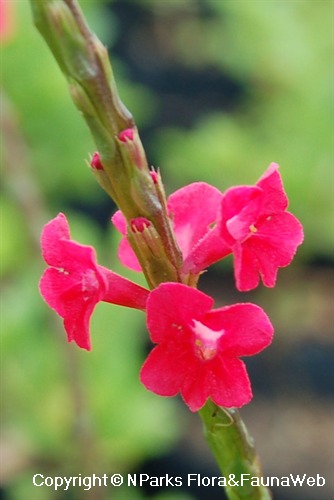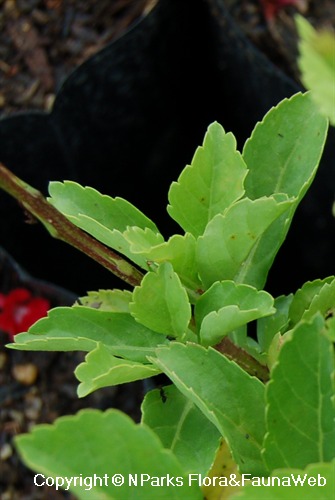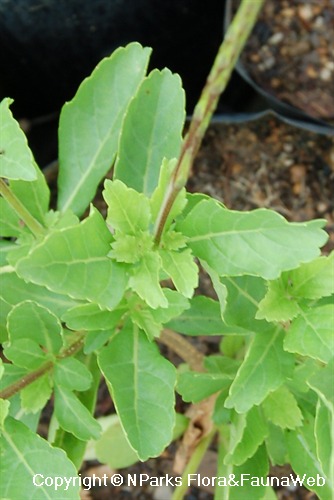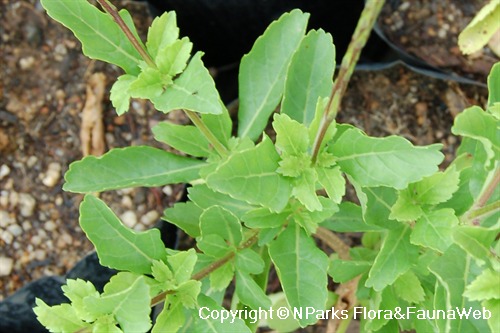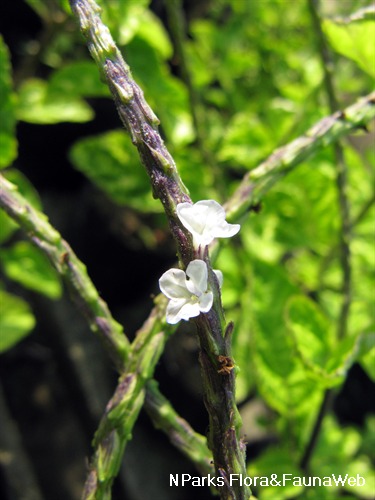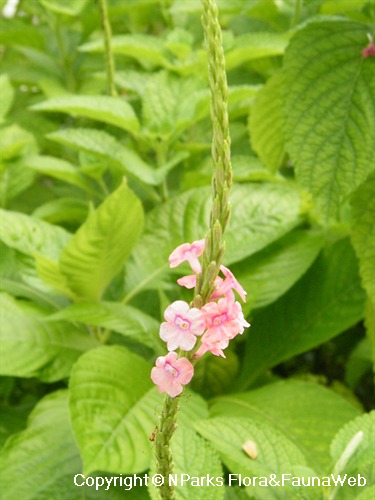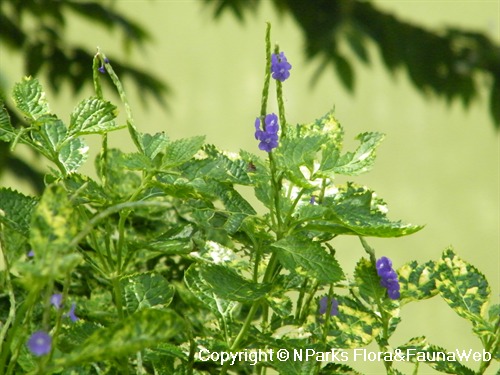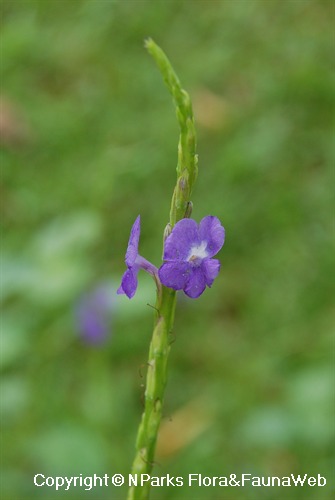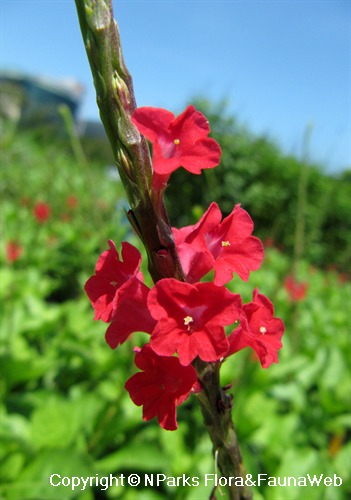
Name
Classifications and Characteristics
| Plant Division | Angiosperms (Flowering Seed Plants) (Dicotyledon) |
|---|---|
| Plant Growth Form | Shrub |
| Lifespan (in Singapore) | Perennial |
| Mode of Nutrition | Autotrophic |
| Plant Shape | Dwarf |
| Maximum Height | 0.3 m to 0.6 m |
| Maximum Plant Spread / Crown Width | 0.6 m |
Description and Ethnobotany
| Growth Form | A woody erect shrub with long prominent spike inflorescences. |
|---|---|
| Foliage | Light green, opposite leaves are approximately elliptic to ovate (5 cm long, 3 - 4 cm wide). They have a dentate leaf margin with teeth of unequal size. Leaves are slightly curled inwards. |
| Stems | Woody stem has tan bark with linear-shaped lenticels. |
| Flowers | Bright red, salverform flowers have 5 unequal lobes and a white throat (1 cm wide). Flowers are arranged on a 15 - 25 cm long terminal spike inflorescence (an inflorescence at the stem tip which has stalkless flowers held along one main axis). Only about 3 - 6 flowers are open at a time, lasting for one day and replaced by a new set the next day. The spike inflorescence blooms in this manner for several weeks. |
| Fruit | Dry, indehiscent fruit is known as a nutlet, a one-seeded small nutlike fruit. It is formed by the fragmentation of a multi-sectioned fruit into single-seeded pieces. |
| Cultivation | Plant in well-drained, fertile soil enriched with compost. To prevent excessive establishment of new seedlings, remove spent flowers before they set seed. |
| Etymology | The genus "Stachytarpheta" comes from the Greek words for spike ("stachys") and thick ("tarphys"). It refers to the long inflorescence found in many species of this genus, |
Landscaping Features
| Landscaping | This cultivar is planted as an ornamental shrub for its bright red flowers. Although the flowers only last for about a day, new flowers are produced every day along the inflorescence spike for several weeks. A mass planting of this cultivar would create a stunning display of red colour. It is ideal for butterfly gardens as a nectar plant. |
|---|---|
| Desirable Plant Features | Ornamental Flowers |
| Landscape Uses | Coastal, Flowerbed / Border, Container Planting |
| Thematic Landscaping | Butterfly Garden |
| Usage Hazard - Cons Remarks | Aggressive growth due to its large seed production. |
Fauna, Pollination and Dispersal
| Fauna Pollination Dispersal Associated Fauna | Butterfly-Attracting |
|---|---|
| Pollination Method(s) | Biotic (Fauna) (Insects (Butterfly, Moth)) |
| Seed or Spore Dispersal | Abiotic |
Plant Care and Propagation
| Light Preference | Full Sun, Semi-Shade |
|---|---|
| Water Preference | Moderate Water |
| Rootzone Tolerance | Fertile Loamy Soils, Well-Drained Soils, Saline Soils / Salt Spray, Moist Soils |
| Propagation Method | Stem Cutting |
| Propagation Method Remarks | Propagate by seed or softwood cuttings. To collect seeds for propagation, allow the seedhead to dry on the plant before harvesting the seeds. |
| Planting Distance | 0 to 0 |
Foliar
| Foliage Retention | Evergreen |
|---|---|
| Mature Foliage Colour(s) | Green |
| Mature Foliage Texture(s) | Smooth |
| Prominent Young Flush Colour(s) | Green |
| Young Flush Texture(s) | Smooth |
| Foliar Type | Simple / Unifoliate |
| Foliar Arrangement Along Stem | Opposite |
| Foliar Shape(s) | Non-Palm Foliage (Ovate, Elliptical) |
| Foliar Venation | Pinnate / Net |
| Foliar Margin | Dentate |
| Foliar Apex - Tip | Acute |
| Foliar Base | Acute, Rounded / Obtuse |
| Typical Foliar Area | Notophyll ( 20.25cm2 - 45 cm2 ) |
Non - Foliar and Storage
| Bark Colour(s) | tan |
|---|---|
| Mature Bark Texture | Lenticellate |
| Stem Type & Modification | Woody |
| Root Type | Underground (Tap Root) |
Floral (Angiosperm)
| Flower & Plant Sexuality | Bisexual Flowers |
| Flower Colour(s) | Red |
|---|---|
| Flower Texture(s) | Smooth |
| Flower Grouping | Cluster / Inflorescence |
| Flower Location | Terminal |
| Flower Symmetry | Radial |
| Individual Flower Shape | Salverform |
| Inflorescence Type | Spike |
| Flowering Period | Free-Flowering |
| Flowering Opening Time | Daytime |
| Flower Lifespan on Plant | 1 Day |
Fruit, Seed and Spore
| Fruit Classification | Simple Fruit |
|---|---|
| Fruit Type | Indehiscent Dry Fruit , Nut / Nutlet |
Image Repository
Others
| Master ID | 30556 |
|---|---|
| Species ID | 4865 |
| Flora Disclaimer | The information in this website has been compiled from reliable sources, such as reference works on medicinal plants. It is not a substitute for medical advice or treatment and NParks does not purport to provide any medical advice. Readers should always consult his/her physician before using or consuming a plant for medicinal purposes. |

